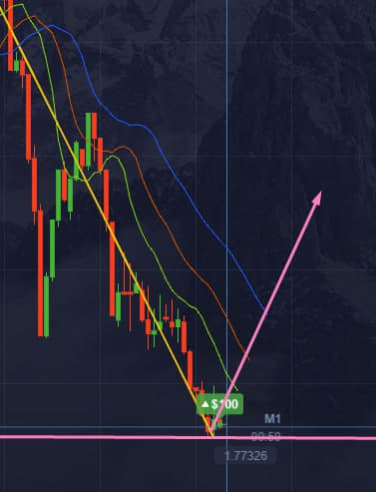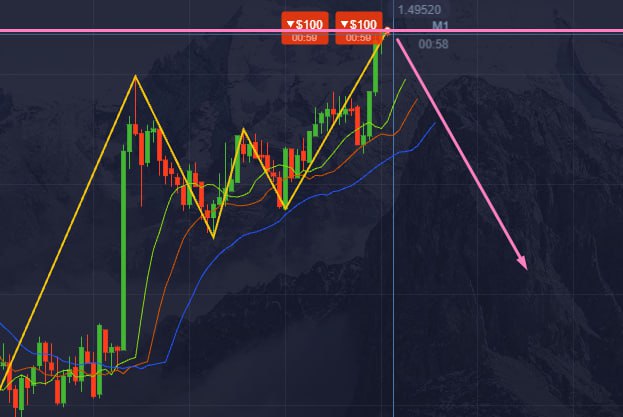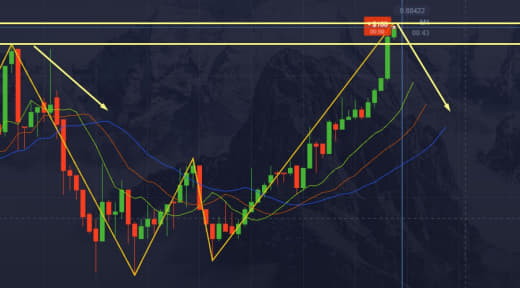2
Short-term trading strategies are a popular way to take advantage of smaller market movements when compared to traditional investments Pocket Option Bollinger . We take a look at this more speculative style of trading and how you can use it.
How long does a deposit take on a Pocket Option? In case of using electronic payment methods, the transaction time can vary from seconds to days. In case of using direct bank wire, the transaction time can be from 3 up to 45 business days.
Is there an inactivity fee for Pocket Option? There is also no inactivity fee charged in case you don't use your account for any length of time.
Introduction 2

Short-term trading involves taking a position that can last from seconds to several days. It is used as an alternative to the more traditional buy-and-hold strategy, in which you’d hold a position for weeks, months or even years.
Short-term trading focuses mainly on price action, rather than the long-term fundamentals of an asset Pocket Option Trading Guide . This trading style attempts to profit from quick moves in market prices, and so seeks out market volatility around key economic data releases, company earnings and political events.Short-term trading is also referred to as active trading, as the style involved differs so heavily from the strategy of investing in or trading passive funds. It is usually speculation based, which means that it doesn’t need to involve the buying and selling of the underlying assets themselves. Instead, short-term traders tend to favour derivative instruments that mean they can enter and exit trades without needing to own the asset itself. These include CFDs, spread bets and options, all of which enable traders to profit from rising and falling market prices.
How to start short-term trading

If you want to start short-term trading, you should:
- Choose which type of short-term trader you’ll be
- Research which markets you can trade short term
- Decide on a short-term strategy
- Practise using your strategy with an IG demo account
- Open an account to trade on live markets
Alternatively, you can continue to learn about different strategies with IG Academy’s range of online courses.
What are the types of short-term traders?

There are a variety of different styles that short-term traders can choose from, depending on their time constraints and risk appetite. These are:
Scalping
Scalpers profit from small price changes by opening positions that can last anywhere between seconds and minutes – but usually not longer. It is by far the shortest of the trading styles listed here.
A scalper will aim to make small profits as frequently as possible by entering a trade and exiting it as soon as the market moves in their favour – ‘scalping’ profits off the top of a market trend. It is the complete opposite to the idea of ‘letting profits run’. These traders grab profits and cut losses as soon as possible in order to maintain a high win to loss ratio.
Scalping is incredibly time intensive and is not for the part-time trader. In fact, many scalpers choose to use high-frequency trading (HTF) as a means of executing a number of orders in seconds. For those looking to trade over the short term, this style can be lucrative but also risky. It is important to be aware of the costs you will incur for opening and closing trades, and to ensure these costs do not erode your profits.
Day traders
Day traders buy and sell assets within a single trading day, often to avoid paying overnight costs. This is classified as a short-term trading style because it seeks to take advantage of small market movements by trading frequently throughout the day.
This style involves making fast decisions in order to get in and out of trades quickly and efficiently. Even within a single trading day there can be vast amounts of volatility, which is needed to create an advantageous trading environment but also create risks to be aware of. For example, rapid price changes can lead to slippage.
However, while day traders will close their trades at the end of each day, many other styles of short-term trading are prepared to let positions run if necessary.
Swing traders
Swing traders focus on taking a position within a larger move, which could last several days or weeks. It is the longest style of short-term trading, as it takes advantage of medium-term movements too.
Swing traders will attempt to spot a trend and capitalise on the rises and falls within the overall price movement. They will often rely on technical analysis to identify the entry and exit points for each trade.
Swing trading is still classed as a short-term trading style, but there is no specific timeframe that constrains it. So, in theory, it could also classify as a long-term trading style as the trend could last longer than a couple of weeks.
What markets can you trade short term?

There are a variety of markets that you can trade over the short term. The trading style places few constraints on how long you would hold a position open – from seconds to weeks – so a market’s opening hours doesn’t necessarily need to have an impact on your methodology. Ultimately, your choice will be based on your personal preferences and interests.
Popular short-term markets include:
Forex
Perhaps the most popular short-term trading market is forex, due to the sheer number of currency pairs that are available to trade 24 hours a day, five days a week.
The market is famous for its high volatility, which provides short-term traders with plenty of opportunities for going long and short on forex pairs. The market is also known for its deep liquidity, which makes it easy to enter and exit positions quickly.
When trading forex using a short-term strategy, if you hold positions open longer than a day, you would incur a rollover fee for doing so.
Although most providers only offer forex markets 24/5, with IG you can trade GBP/USD on weekends too.
Shares
There are thousands of shares available to trade across stock markets all over the world. It is the huge variety that makes share trading so popular with both long-term and short-term traders.
Although stock markets do have specific trading hours – meaning there will be less volatility out of hours – they are still a favourite for those looking to trade short term. You’d either employ a day trading strategy and close trades out at the end of each day or hold positions over a few days.
It is also worth bearing in mind that some brokers do offer out-of-hours trading on shares. For example, with IG you can trade 90 key US stocks outside of market hours to make the most of company announcements.
There are two different routes to taking a position on shares: investing through our share dealing service or speculating on the future market price via CFDs and spread bets. However, trading is more suited for use over the short term, as it opens up the prospect of going both long and short on the price of shares.
Indices
Short-term trading indices would fall into a similar pattern as share trading, as there are still restrictions of market hours. So, you would either look to follow a day trading style to focus on intraday movements or maintain a position over a few days to a week.
When you trade indices, you’d be speculating on a number of different companies shares rather than an individual stock. This means that you gain a much larger market exposure, but that you’ll also need to be aware of a lot more factors that could impact your position.
It’s worth noting, that like our out-of-hours forex and shares markets, we also offer certain weekend indices markets.
Cryptocurrencies
The cryptocurrency market is open 24 hours a day, seven days a week, 1 which provides plenty of opportunity for short-term traders. The volatility of cryptocurrencies, such as bitcoin, also creates a lot of interesting market movements that short-term traders can seek to take advantage of.
As with any market, it is important to have a suitable risk-management strategy in place before starting to trade – but as the cryptocurrency market is still comparatively new, it’s even more vital to have a thorough knowledge of the asset and how to trade it.
Commodities
Trading commodities enables you to take a shorter-term view on a range of assets such as oil, gold, silver, wheat and sugar.
With IG, there are no fixed expiries on our commodity products, 2 which means that short-term traders can define their own parameters – trading over whichever timeframe they deem necessary. Trading commodities works in broadly the same way as indices trading, in that you’ll pay a funding charge for holding positions overnight.
Four short-term trading strategies
A trading strategy is nothing more than a methodology for identifying advantageous entry and exit points for trades. It outlines exactly when you will trade, and at which point you will either take a profit or close your trade to prevent unnecessary losses.
Most short-term trading strategies rely on technical analysis, which includes a huge range of indicators that can help traders identify these key price level to trade at.
Popular short-term trading strategies include:
- Momentum trading
- Range trading
- Breakout trading
- Reversal trading
Momentum trading
Momentum trading involves buying and selling assets based on the strength of a recent trend – the idea is that if there is enough force behind a current market movement, then this move is likely to continue.
If a price has been increasing in the short term, it will attract attention from other market participants and push the price even higher. Likewise, if a market price starts to fall, it will attract more short-sellers who will push the price downward.
Momentum traders will seek to identify the strength of upward and downward trends and capitalise on the main body of movement rather than trying to find the ‘top’ or the ‘bottom’.
Moving averages (MAs) can help momentum traders to determine whether a stock is expected to increase or decrease. If a stock is primed to rise, it will generally have a moving average that is sloping upward. However, if you were looking to short a stock, you’d be looking for a price chart that has a declining or plateauing moving average.
Traders often use a moving average cross over to identify entry and exit points for their positions. This is formed using two moving averages, one slow MA – which pulls in data from a longer period of time – and one fast MA, which takes data from a shorter timeframe. A momentum trader would enter into a long position when the fast exponential moving average (EMA) crosses the slow EMA from below, and enter into a short position when the fast EMA crosses the slow EMA from above.
Practise using a momentum trading strategy in a risk-free environment with an IG demo account.
Range trading
Range trading is a popular short-term strategy that seeks to take advantage of a market trading within lines of support and resistance. For longer-term traders, range bound markets can be perceived as boring as they do not provide huge movements. However, for those who adopt a shorter outlook, they can provide ample opportunity for skimming quick profits from small movements.
A range trader looking to go long would open a position at a known level of support, and ride the oscillation upward until it hits the level of resistance – where they would usually place a limit order to close out the trade automatically to lock in profits. A range trader looking to go short would open a position at a known level of resistance, and take advantage of the price falling to its support level – where a limit order would be.
There are a variety of technical indicators that range traders can use, such as the stochastic oscillator or relative strength index (RSI), which identify overbought and oversold signals. Range traders will also use tools, such as the Bollinger band or fractals indicators, to identify when the market price might break from this range – indicating it is time to close the position.
Practise using a range trading strategy in a risk-free environment with an IG demo account.
Breakout trading
Breakout trading involves entering a trend as early as possible ready for the market price to break out of a range. This strategy is commonly used by short-term traders who subscribe to day trading or swing trading styles.
These traders will seek to identify a point at which there is a change in market sentiment, which could indicate volatility and the start of a new trend. By entering the market around these price points, traders can seek to ride a trend from start to finish.
Limit-orders are a key tool in breakout trading, as they enable traders to automatically enter a trade by placing the orders at a level of support or resistance. This way, if a breakout does occur, the trade is executed without the individual having to monitor the market.
Many breakout strategies use volume indicators such as the money flow index (MFI), on-balance volume and the volume-weighted moving average. Breakout traders will often assume that when volume levels start to increase, there will soon be a breakout from a support or resistance level.
Practise using a breakout trading strategy in a risk-free environment with an IG demo account.
Reversal trading
The reversal trading strategy is based on identifying when a current trend is going to change direction. A reversal can occur in both directions, as it is simply a turning point in market sentiment.
A ‘bullish reversal’ indicates that the market is at the bottom of a downtrend and could become an uptrend. While a ‘bearish reversal’ indicates that the market is at the top of an uptrend and could become a downtrend.
Focusing on the immediate price reversal can provide quick profits for short-term traders who identify the most advantageous price levels. The Fibonacci retracement is a common tool, used to confirm whether the market surpasses known retracement levels and is in a full reversal.
Practise using a reversal trading strategy in a risk-free environment with an IG demo account.
What to bear in mind before you start short-term trading
Before you start short-term trading, there are a couple of factors you should be aware of that can have a huge impact on your positions:
Execution and pricing technology
Short-term trading does have certain requirements in terms of technology due to the speed of execution that is needed to enter and exit positions quickly. In short-term strategies, fast execution can be the difference between profit and loss.
This is why it is important to use a platform specifically engineered to give you speed, stability and the best prices possible. Most platforms that offer the full experience come at a significant price, but IG’s online trading platform is completely free for clients – so all you’d need to do is open a live account with us.
Alternatively, if you’d like to practise using our platform before you trade, you can always practise in a risk-free environment first by using an IG demo account.
Slippage
Perhaps the most significant risk caused by slow execution is slippage. This is when the price at which your order is executed differs from the price that you requested. It happens in fast moving markets when your broker cannot place the trade quick enough to secure the price you asked for.
Some brokers would fill your order at the new, often worse, price. However, IG’s best execution policy ensures that if the price moves outside of our tolerance boundaries, we would reject your order to protect you from slippage and give you the choice to trade at the new price. If the market price did move in your favour after your order was placed – known as positive slippage – then IG would execute your trade at this better price.
We also provide the option of attaching a guaranteed stop to your position. Unlike normal stops, which are still impacted by slippage, a guaranteed stop is always executed at your pre-selected price. And with IG, you would only pay a premium if your guaranteed stop-loss is triggered.
Find out more about managing your risk with IG
1 With IG, you can trade cryptocurrencies against fiat currencies – such as the US dollar – from 4am Saturday to 10pm on Friday (UK time).
2 In the case of all DFBs, there is a fixed expiry at some point in the future.